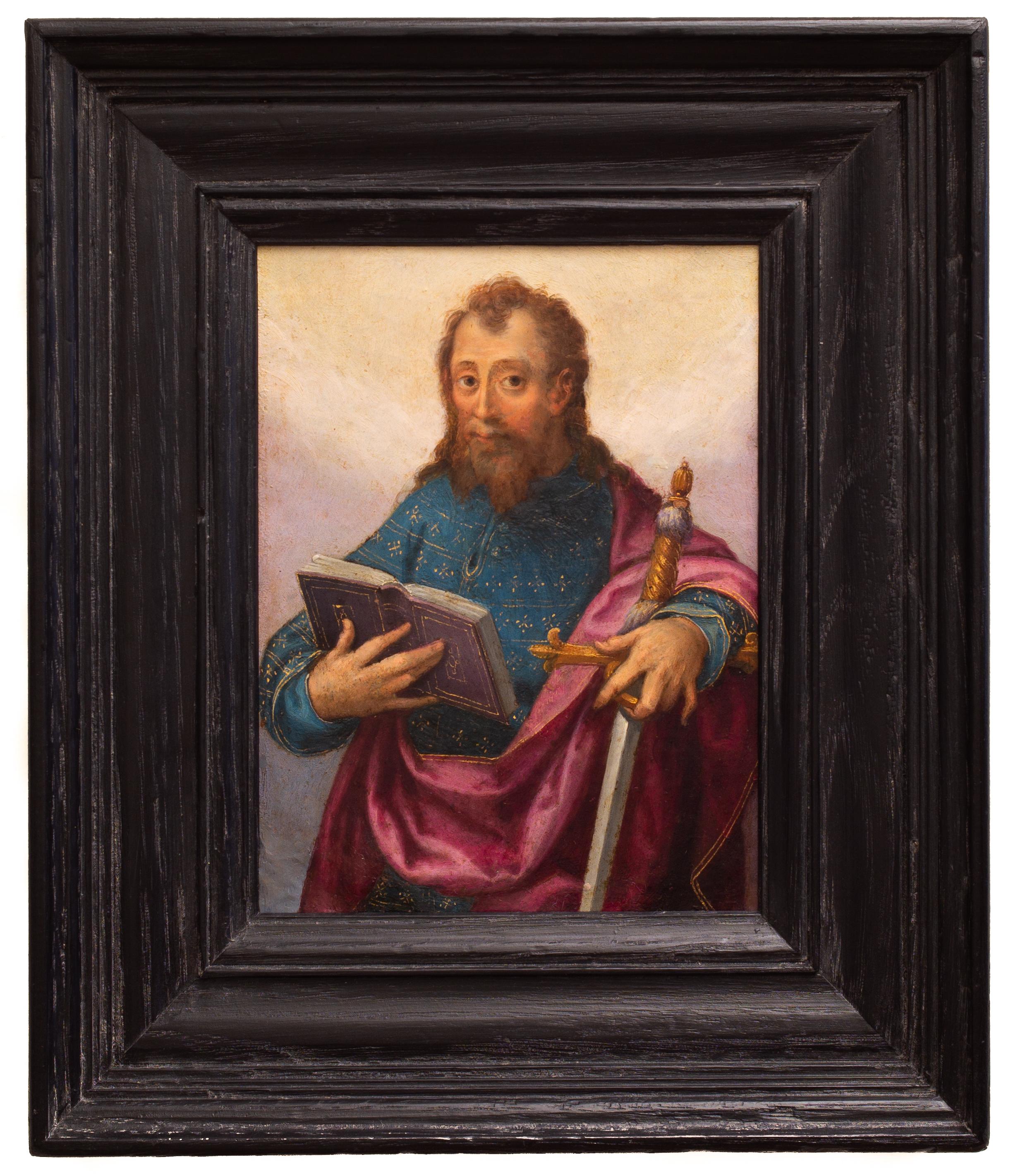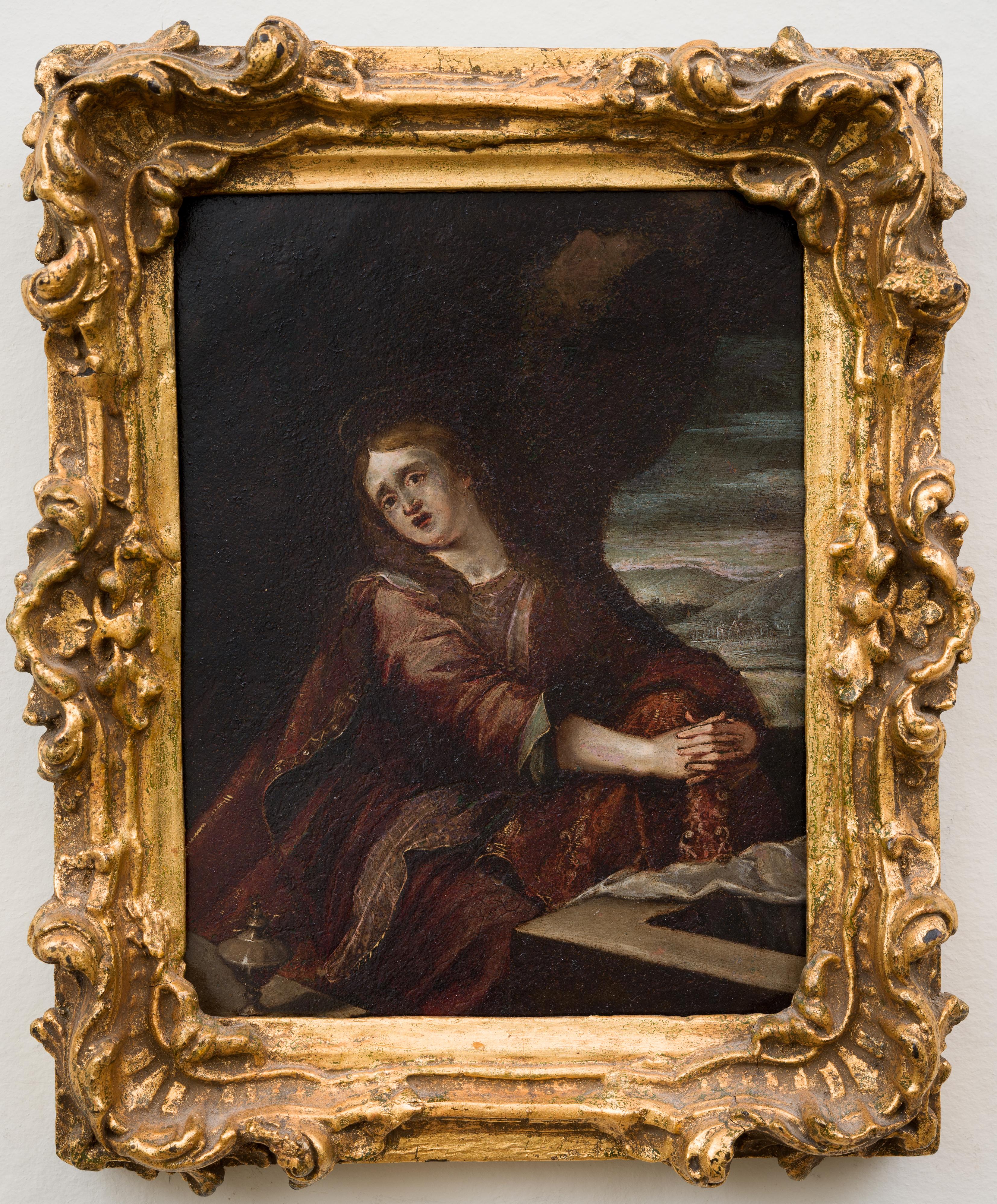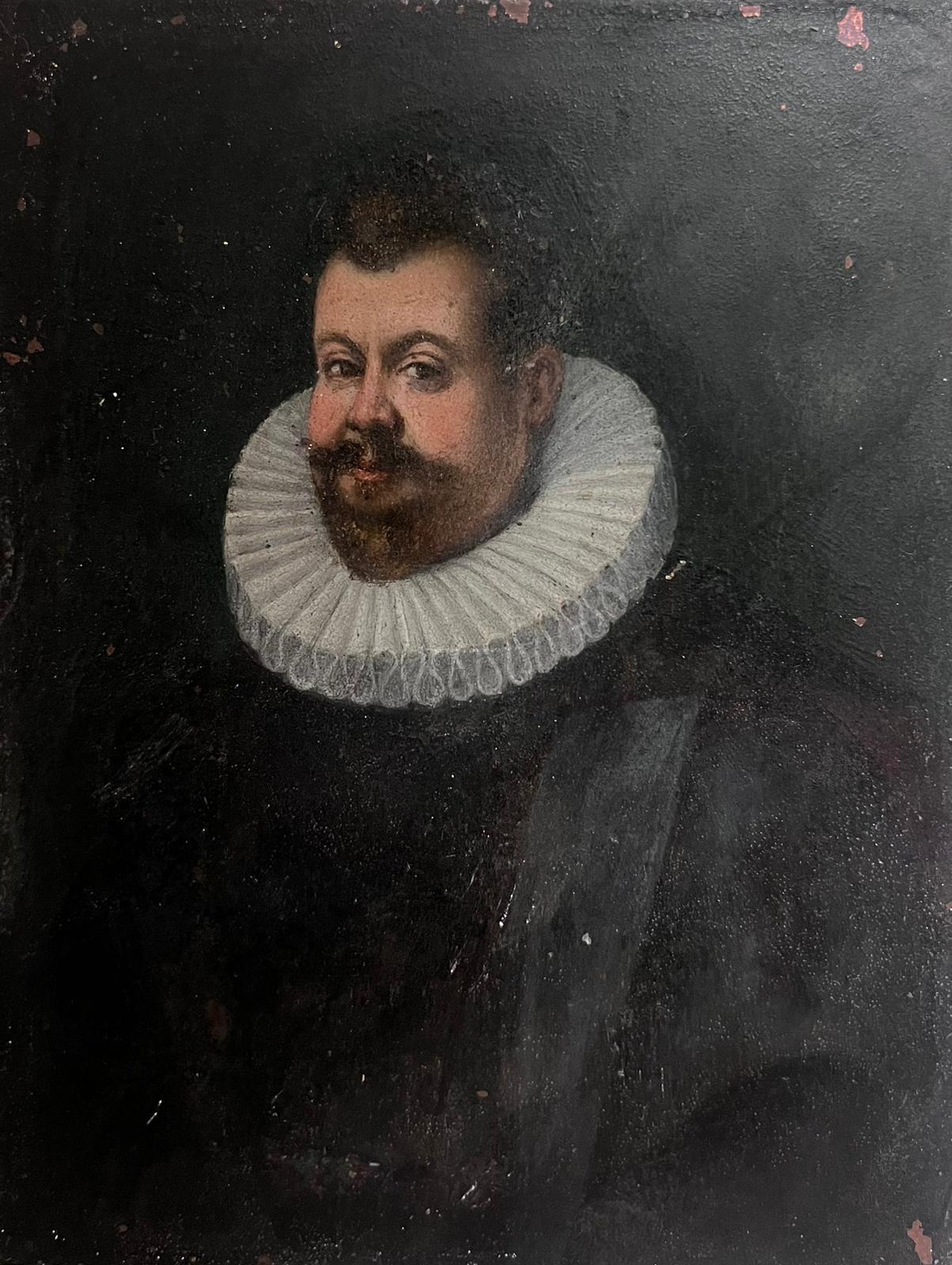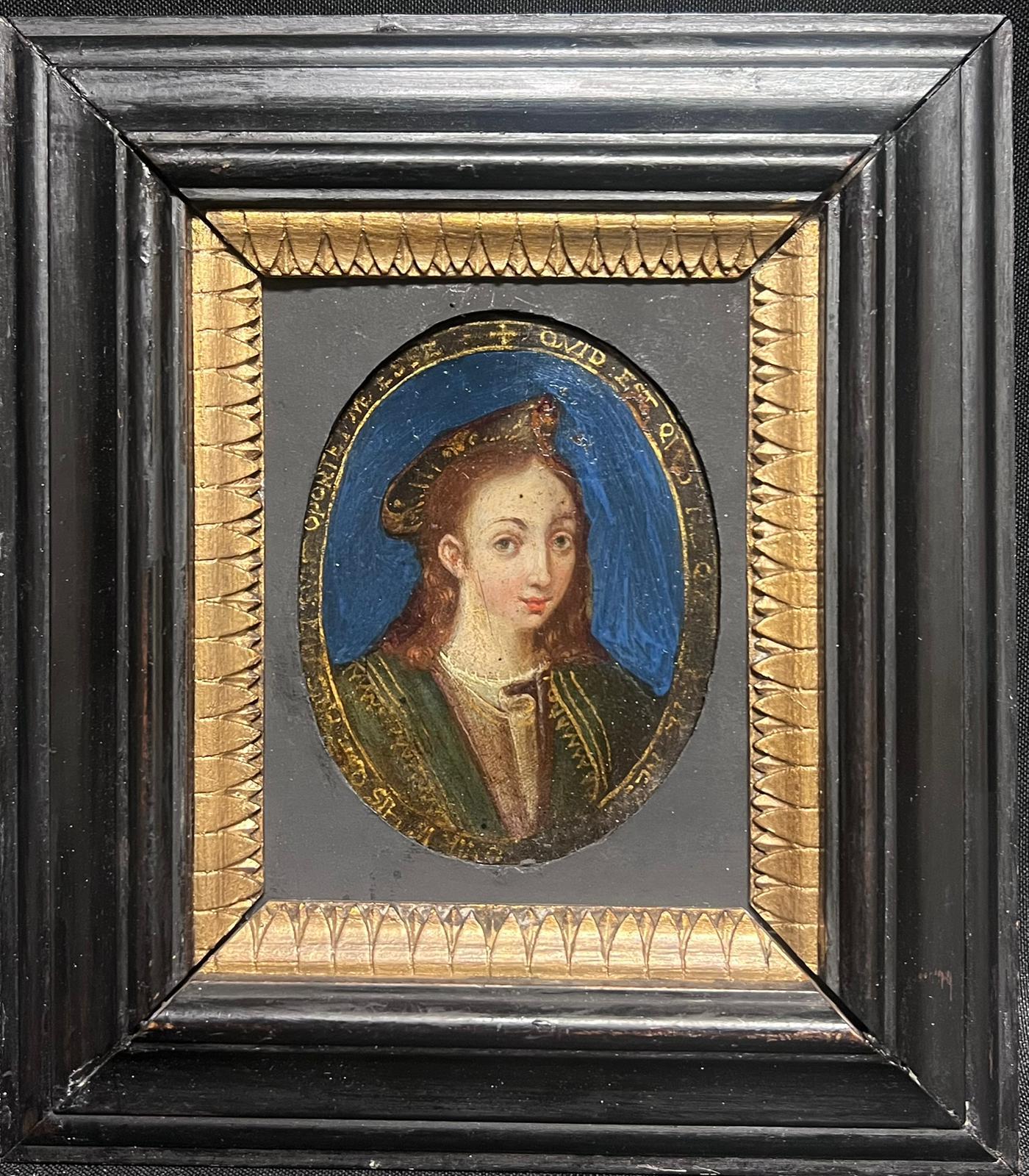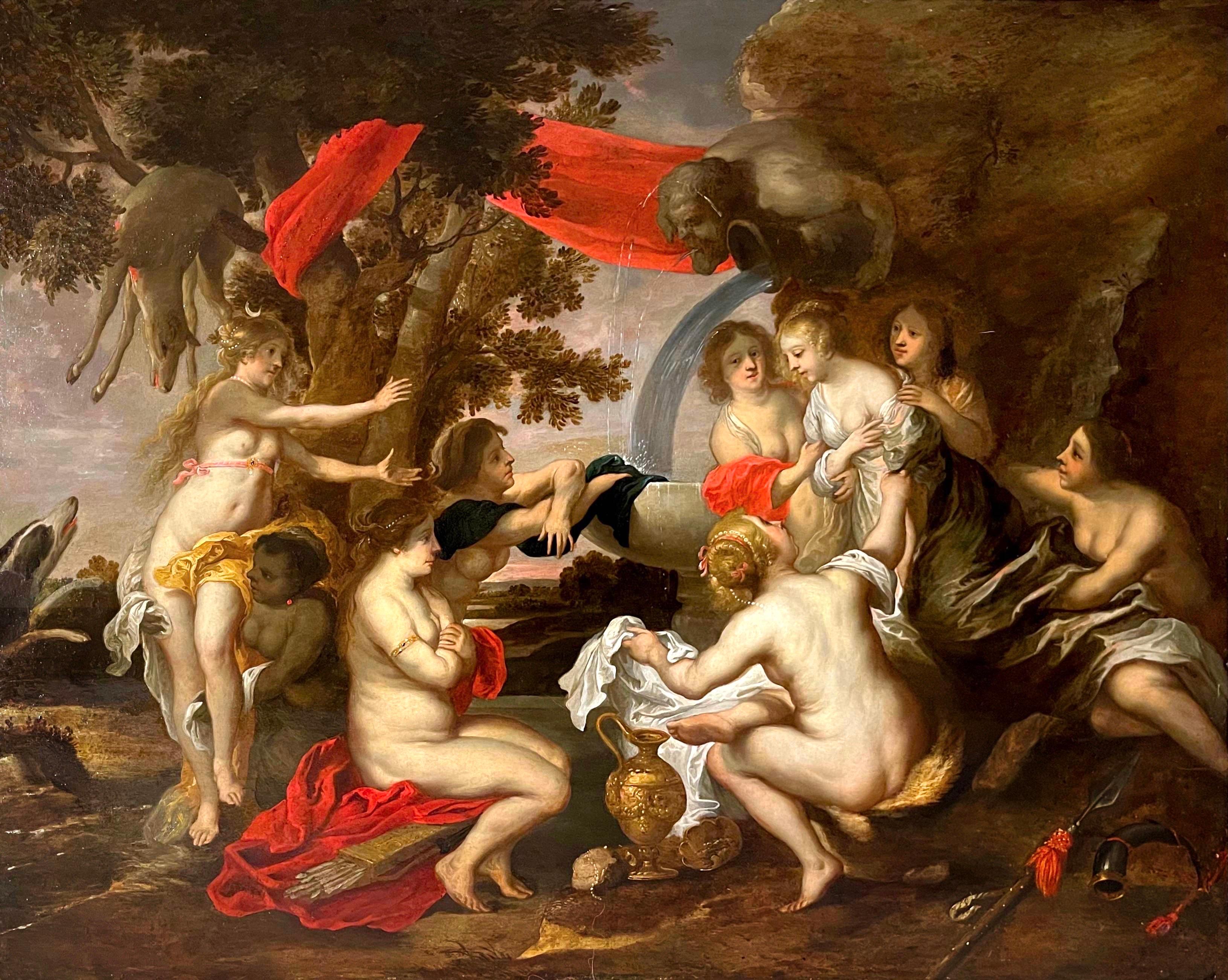Items Similar to 17th century Flemish old master painting - Adoration of the Shepherds Christmas
Want more images or videos?
Request additional images or videos from the seller
1 of 15
Victor Wolfvoet the Younger17th century Flemish old master painting - Adoration of the Shepherds Christmas
About the Item
17th century Flemish Old master painting "Adoration of the Shepherds" by Victor Wolfvoet the Younger
Surrounded by an elegant and broad black frame, it feels like the spectator is stepping into this very intimate scenery, with the Christ child radiating light and love. The adoration and awe of the Shepherds feels clearly palpable, as is the love of the parents for their child. It's a truly special and heartwarming painting.
Victor Wolfvoet the Younger was born in Antwerp in 1612 as the son of Victor Wolfvoet the Elder, a painter and art dealer, and Brigitta Voorwercx. He became a member of the Antwerp Guild of Saint Luke around 1644-5 and some sources refer to Wolfvoet as a pupil of Rubens. The artist's estate comprised a substantial collection of artworks of seven hundred items. The inventory of his estate lists twenty sketches by Rubens, including several designs for the ceilings of the Carolus Borromeus Church in Antwerp and six bozzetti for the Triumph of the Eucharist tapestry series. There are also sketches by other artists, many unattributed sketches and framed grisailles, and a number of sketches after Rubens. Some of the sketches were likely in Wolfvoet's own hand, like his copies after Rubens' Abraham and Melchizedek and Manna from Heaven both now in the Mauritshuis, The Hague. The large collection of works has been regarded as evidence that the artist may also have been active as an art dealer. His oeuvre has long remained in obscurity and has only recently been placed back into the spotlight it deserves. A copy of an article published on the artist in the Burlington magazine will be included in the information pack for the buyer.
Currently a cabinet with oil paintings by Wolfvoet, which was long on display in the Rubenshouse museum, is included in an exhibition showcasing several works of the Flemish masterpieces-list at the MAS museum in Antwerp. This is a list of works of art in Flemish collections which are considered as highly important and irreplaceable masterpieces, the cabinet with paintings by Wolfvoet is included in this list.
The oil on copper measures ca. 50 by 43 cms and with the custom-made new frame ca. 70 by 63 cms.
Provenance: private collection Spain
- Creator:Victor Wolfvoet the Younger (1612 - 1652, Flemish)
- Dimensions:Height: 19.69 in (50 cm)Width: 16.93 in (43 cm)Depth: 0.4 in (1 cm)
- Medium:
- Movement & Style:
- Period:
- Framing:Frame IncludedFraming Options Available
- Condition:As photographed, lovely and ready to hang. Some small inpainting visible under uv-light, natural wear of the copper plate. The colors are vivid, but as with all paintings, a good light will bring them out even more.
- Gallery Location:Antwerp, BE
- Reference Number:1stDibs: LU1423213436782
About the Seller
5.0
Gold Seller
These expertly vetted sellers are highly rated and consistently exceed customer expectations.
Established in 2020
1stDibs seller since 2020
353 sales on 1stDibs
Typical response time: 4 hours
- ShippingRetrieving quote...Ships From: Antwerp, Belgium
- Return PolicyA return for this item may be initiated within 2 days of delivery.
More From This SellerView All
- Large 17th century Flemish old master painting - Diana and Callisto - RubensLocated in Antwerp, BE17th century Flemish Old master painting "Diana and Callisto" attributed to Victor Wolfvoet the Younger Our painting is based on Rubens' great work of...Category
17th Century Old Masters Figurative Paintings
MaterialsCopper
- 17th century Flemish Old Master - A young boy enjoying a pie, allegory of tasteLocated in Antwerp, BE17th century Flemish old master painting, Allegory of taste The very fine painting depicts a young boy, cheekily tasting a delicious pie. He's looking at the viewer with eyes twinkl...Category
17th Century Old Masters Figurative Paintings
MaterialsCanvas, Oil
- 18th century Portrait of a lady as Erato, the muse of poetry - Angelica KauffmanBy Angelica KauffmannLocated in Antwerp, BE18th century English school portrait of a lady, said to be Mrs. John Ruscombe of Colne, Lancaster, as the muse Erato This very skilfully painted portrait depicts a lady as the muse Erato, playing the Lyre. Her eyes are filled with emotion and her lips are curved in a soft, delightful smile. Hinting at the love song she is composing? Erato is one of the nine Muses in Greek mythology. She is the muse of lyric poetry, love poetry, and mimicry. Erato is often depicted holding a lyre, symbolizing her association with music and poetry. She inspires poets and writers to create works that celebrate love, beauty, and human emotions. Our painting was sold in the early 1900s as a work by Angelica Kauffman. Kauffman was an 18th-century Swiss Neoclassical painter who achieved significant success and recognition in a male-dominated art world. Born in Switzerland in 1741, she showed exceptional talent from a young age and received formal art training in Italy. Kauffman gained fame for her historical and mythological paintings, as well as her portraits, which were characterized by their grace, elegance, and classical influences. She was a founding member of the Royal Academy of Arts in London and enjoyed patronage from aristocrats and royalty throughout Europe. Kauffman's work contributed to the rise of Neoclassicism and she remains one of the most prominent female artists of her time. Measurements: Oil on canvas ca. 98 by 77cm and with the frame ca. 118 by 97 cm Provenance: Collection of Felix Gouled American Art Association, Anderson Galleries, by 1937 Kende Galleries at Gimbel Brothers, Jay Gould...Category
18th Century Old Masters Portrait Paintings
MaterialsCanvas, Oil
- 17th century Allegory of the four Elements - Frans Francken the Younger FlemishBy Frans Francken IILocated in Antwerp, BEVery fine 17th century Flemish old master "Allegory of the four elements" attributed to Frans Francken the Younger The figures are the Nereid Amphitrite, holding a coral and represe...Category
17th Century Old Masters Figurative Paintings
MaterialsOil, Panel
- 17th century German portrait of a man - Wine merchant Caspar Roemerskirchen 1628Located in Antwerp, BE17th century German portrait of the wine merchant Caspar Roemerskirchen at the age of 26 in 1628, attributed to Gottfried de Wedig This highly decorative portrait depicts the 26 yea...Category
17th Century Old Masters Portrait Paintings
MaterialsOil, Wood
- 17th century Flemish Old master - Silenus feasting - Wine GodLocated in Antwerp, BE17th century old master painting "Silenus feasting", likely studio of Sir Anthony Van Dyck Born in Antwerp in 1599, Anthony Van Dyck entered the studio of Rubens (1577 - 1640) at the age of nineteen. Quickly, the master perceives the talents of the young prodigy and makes him his first assistant. Van Dyck, for his part, has a particular admiration for the man whose name is known throughout Europe. In 1619, he was inspired by a drunken Silenus by Rubens, produced one or two years earlier for a composition on the eponymous theme. This work, now in the Dresden Museum, appears to be the first version of our painting. That work has an illustrious provenance; it was recorded in the private collection of Leopold Wilhelm (Archduke of Austria) in 1662, in 1722 it was bought by the famous German painter Antoine Pesne for the King of Saxony in Dresden (Staatliche Kunstsammlungen Dresden - Gemäldegalerie Alte Meister, Dresden, inventory number 1017). From 1945 until 1955 it was on display at the Pushkin Museum in Moskou, after having been taken by Russia after the Second World War. It was then returned to the Staatliche Kunstsammlungen Dresden where it is still on display. Our painting is of a fine quality and has been painted by a skilled and confident hand. It displays some slight variations in the composition when compared to the original; the legs of Silenus are smoother and less hairy, more humanoid than satyresque. There might also be a pentimento visible at the level of the legs where one observes traces of hair on and under the material. This area can be compared to that of a canvas by Van Dyck kept in Brussels, of a still drunk Silenus whose animal legs are formally treated in the same way as the ones in our composition. Furthermore, the skirt of the figure to the far left has a purplish-red colour in our work, whereas in the first version it appears to be white. There also appear to be differences in the sky, firstly the clouds are shaped slightly different, the sky in our painting has a more vivid colour and there is also a golden hue of a sunset visible to the far left. This treatment of the background appears close to that of a Saint Rosalie, now kept at the Metropolitan Museum in New York and dated 1625, which might offer a reference for dating our painting. In the evanescent aspect, as non finito of its figures, it is interesting to compare our Silenus to a Saint Sebastian, conserved in the Escorial Museum in Madrid. Also, the theme remains rather curious. According to Barnes and Porter, Rubens, like Van Dyck after him, was partly inspired by Book XI of Ovid's Metamorphoses, but a second literary or pictorial source remains unknown (1). For the original composition, Stephan Maaser, art historian, establishes a correspondence between the position of Silenus, referring to that of a Christ at the moment of the Lamentation or the Descent from the Cross (2); the female characters on the left and the male on the right refer more to Mary Magdalene and Saint John than to the Phrygians or the members of a bacchanalian procession. Finally, note that Silenus is not usually a faun. The success of the composition at the time of its public reception and its engraving by Franciscus van der Steen really contributed to the dissemination of the work. At the same time, it testifies to the intense activity of the painter and his studio in Antwerp, before he left to work at the English court. About Silenus: In greek mythology, Silenus was the tutor and foster-father of the wine god Dionysos, who was entrusted to his care by Hermes after his birth from the thigh of Zeus. The young god was raised by Silenus and nursed by the Nysiad nymphs in a cave on Mount Nysa. Silenus was, in essence, the spirit of the treading dance of the wine-press, his name being derived from the words seiô, "to move to and fro," and lênos, "the wine-trough." Once, when Dionysos was travelling through Phrygia, Seilenos became lost and was captured by King Midas. The king treated him hospitably and as a reward Dionysos granted him his golden touch. The artists biography: Born in Antwerp on 22 March 1599, Anthony van Dyck was the seventh child of Frans van Dyck, a wealthy silk merchant, and Maria Cuypers, who was renowned for her embroidery skills. In 1609, when he was ten years old, his parents apprenticed the precocious youth to Hendrik van Balen (1575-1632), a painter of small cabinet pictures and dean of the city's Saint Luke's Guild. Although the length of Van Dyck's stay with Van Balen is not known, it probably lasted three to four years. Van Dyck registered as a master in the Antwerp Saint Luke's Guild on 11 February 1618, by which time he was already in demand as a portrait painter (see the NGA painting, Portrait of a Flemish Lady...Category
17th Century Old Masters Figurative Paintings
MaterialsOil, Canvas
You May Also Like
- St Paul With Sword and Book, Mannerist School, Oil on CopperLocated in Stockholm, SEMannerism, derived from the Italian term "maneria," which simply means "style," was an artistic movement that emerged in the later years of the Italian High Renaissance, around 1520, and extended into the early 17th century. It is often referred to as the "stylish style" due to its emphasis on self-conscious artifice rather than realistic depiction. Historians debate whether Mannerism should be classified as a style, a movement, or a period. In contrast to the harmonious ideals embraced by renowned artists such as Raphael, Michelangelo, and Leonardo da Vinci, Mannerist painters took a step further and created compositions that were almost bizarre. They introduced fresh color schemes, elongated proportions, and exaggerated anatomy of figures, portraying them in convoluted and serpentine poses. These artists skillfully exhibited their techniques and abilities, aiming to evoke a sense of sophisticated elegance. Among the notable Mannerist painters are Jacopo da Pontormo, Bronzino, Lavinia Fontana...Category
17th Century Old Masters Figurative Paintings
MaterialsCopper
- Flemish School, 17th Century, Mary MagdaleneLocated in Stockholm, SEFlemish School, 17th Century Mary Magdalene oil on copper 17th century plate dimensions 23 x 17 cm frame 27 x 22 cm Restored by professional art conservator 2022. Provenance: ...Category
17th Century Old Masters Figurative Paintings
MaterialsCopper
- Fine 1700's French/ Dutch Oil Painting on Copper Portrait Man Ruff CollarLocated in Cirencester, GloucestershirePortrait of a Gentleman wearing a Ruff Collar Dutch/ French artist, 18th century oil painting on copper, unframed copper board : 6.75 x 5 inches provenance: private collection, UK co...Category
18th Century Old Masters Figurative Paintings
MaterialsCopper
- Fine 17th Century Italian Old Master Oval Portrait of Lady on Copper Wooden FrmLocated in Cirencester, GloucestershirePortrait of a Lady Italian Old Master, 17th century oil on copper, framed framed: 8.75 x 7.75 inches painting: 5 x 4 inches provenance: private collection, England condition: very go...Category
17th Century Old Masters Portrait Paintings
MaterialsCopper
- Annunciation to the Virgin Attributed to Cornelis SCHUTLocated in Pasadena, CAEarly 17th-century copper painting depicting a religious scene, School Annunciation, Oil on Copper attributed to Cornelis SCHUT, painter of Antwerp (159...Category
17th Century Old Masters Figurative Paintings
MaterialsCopper
- 17thC Spanish Colonial School Frame with orig. Painting St. Joseph Jesus ChildBy Spanish Colonial (Peruvian)Located in Meinisberg, CH17th Century Spanish Colonial School (Likely to be School of Cuzco in Peru) - St. Joseph with the Christ Child carrying a basket, housed in its original carved, hardwood frame. • Painted in oil on canvas (laid on to fiberboard), ca.58 x 48 cm • Original frame, ca. 64 x 54 cm • Visible image ca. 52.5 x 42.5 cm Centuries ago this religious painting, depicting St. Joseph with his flowering staff and the Christ Child carrying a basket, was originally displayed in a church or chapel in 17th Century colonial...Category
17th Century Old Masters Figurative Paintings
MaterialsGold Leaf
Recently Viewed
View AllMore Ways To Browse
The Antique
The Evidence
Large Old Master
Master Copy
Old Copper
Old Spanish Paintings
Flemish Masters
Flemish Paintings Century
Flemish Paintings
The Shepherd
Flemish Frame
17th Century Old Master
Old Master Painting 17th Century
Ceiling Painting
Paintings Of Heaven
Spain Old Masters
Old Spanish Master
Old Master Flemish
